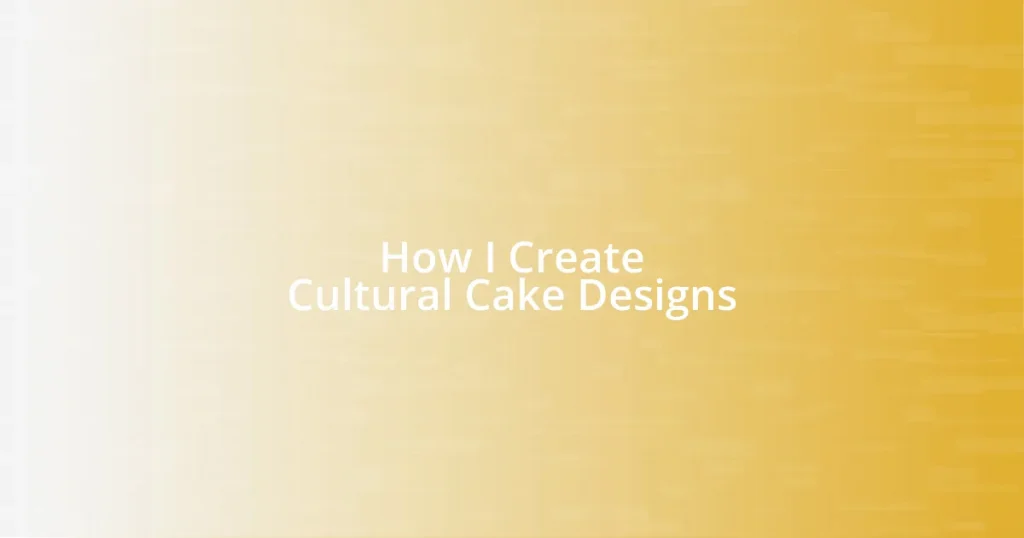Key takeaways:
- Cultural cake designs embody tradition, storytelling, and community identity, reflecting cultural values through ingredients and patterns.
- Researching the cultural significance and history of ingredients enhances authenticity and emotional resonance in cake creations.
- Incorporating symbols and narratives from specific cultures fosters a connection and appreciation among people celebrating those traditions.
- Showcasing cake designs on social media can spark curiosity and connection, transforming a cake into a piece of art that tells a story.

Understanding Cultural Cake Designs
Cultural cake designs are more than just decorative elements; they tell stories steeped in tradition and significance. When I first encountered a traditional Japanese sakura (cherry blossom) cake, I was struck by the delicate artistry involved. It made me wonder: how do ingredients and patterns reflect the values of a culture?
Every culture has its iconic cakes that celebrate pivotal moments, from wedding ceremonies to festive holidays. I remember experiencing the vibrant colors of a Mexican tres leches cake at a family gathering, where each slice became a conversation starter about our heritage. It’s fascinating how something as simple as a cake can evoke memories and connect us to our ancestry, isn’t it?
Understanding cultural cake designs requires an appreciation for the symbolism behind each element. Take, for example, the intricate designs of Indian wedding cakes, often adorned with paisley patterns that symbolize fertility and abundance. The more I explore these designs, the more I realize they are a fusion of art, celebration, and identity, capturing the essence of who we are as communities. How deeply intertwined can our culinary choices be with our senses of self?

Researching Cultural Backgrounds
Researching cultural backgrounds is a crucial step in creating authentic cake designs that honor traditions and narratives. I recall the moment I dived into the history of Italian Panettone. The more I learned about its roots in Milan, deeply entwined with Christmas celebrations, the more inspired I became to incorporate elements that celebrate family gatherings and joyful festivities. It’s all about understanding the stories that each cake carries with it, and how those narratives can enhance my designs.
I’ve also discovered that food is a universal language, speaking volumes about cultural values. For instance, while studying the significance of the Greek Kourabiedes during weddings, I was moved by the pastry’s role in symbolizing love and unity. The distinct almond flavor, dusted with powdered sugar, evokes warmth and hospitality. Reflecting on such nuances not only enriches my appreciation for culture but also allows me to create cakes that resonate emotionally with those sharing them.
Further exploration into diverse cultural traditions reveals fascinating insights into ingredients and techniques passed down through generations. As I investigated the symbolic motifs used in African cake designs, I found a vibrant tapestry of colors and patterns that signify prosperity and abundance. Each design choice feels like a storytelling moment that I can incorporate into my cakes to celebrate diverse heritages, making each creation not just a cake, but a piece of cultural history.
| Cultural Aspect | Significance |
|---|---|
| Italian Panettone | Symbolizes family gatherings during Christmas. |
| Greek Kourabiedes | Represents love and unity during weddings. |
| African Cake Designs | Colors and patterns signify prosperity and abundance. |

Choosing Appropriate Ingredients
When it comes to choosing ingredients for cultural cake designs, I find that authenticity is key. Each ingredient brings with it a sense of place and tradition that helps to enhance the story I’m telling through my cake. For instance, sourcing real matcha from Japan for a green tea cake not only gives it the correct flavor but also celebrates the cultural significance of this beloved ingredient. It’s those small details that make a world of difference.
To ensure I select the most appropriate ingredients, I consider the following factors:
- Cultural Significance: Understanding why certain ingredients are important in traditional recipes.
- Flavor Profiles: Matching ingredients to the tastes typically celebrated in the specific culture.
- Quality Sources: Sourcing high-quality ingredients that are true to the original recipes, like importing saffron for a traditional Moroccan cake.
- Seasonality: Choosing ingredients that are in season to honor the local farming traditions of a particular culture.
- Substitutions: Knowing when and how to substitute without losing the integrity of the cultural dish.
I remember experimenting with coconut in a Brazilian cake recipe; it was a revelation! Coconut is not just a flavor; it’s a nod to the tropical origins of many Brazilian desserts. Each time I bake with ingredients that are deeply rooted in tradition, I can feel those cultures kindling in my kitchen, creating a beautiful bridge between past culinary practices and my own artistry. It’s a joy to create something that not only tastes wonderful but also resonates with the rich stories of a culture.

Designing with Cultural Symbols
Incorporating cultural symbols into cake designs is not just an art; it’s a profound expression of identity and heritage. I remember when I first introduced Henna patterns into a wedding cake. It wasn’t just about the aesthetics; that intricate design connected the cake to the joyous occasion, celebrating a culture rich in tradition. Each swirl and dot told a story, reminding guests of the ceremony’s beauty and significance.
Symbols can evoke powerful emotions and signal cultural values. For instance, during my exploration of Indian celebrations, I used lotus flowers as a motif for a birthday cake. The lotus is a symbol of purity and rebirth in many cultures, and integrating it into my design was a way to honor not only the festivities but also the shared beliefs of the family. It’s like inviting everyone into a dialogue—encouraging them to reflect on their own memories and experiences while enjoying a delicious slice.
As I explore various cultural symbols, I often wonder how these elements resonate with others. At times, I’ve used traditional designs from Native American pottery on my cakes, feeling a connection to nature and the earth. Each cake decorated with these symbols becomes a canvas that tells a unique story, evoking pride and creating a moment of reflection for those who partake in it. The beauty of this practice lies in its ability to unite people across cultures through shared symbols and meaningful narratives.

Techniques for Cake Decoration
There are numerous techniques I love using when decorating cakes, each offering a new avenue for creativity. One of my favorite methods is piping, which allows me to transform a simple frosting into intricate designs. I remember the first time I decorated a cake with buttercream flowers; the delicate petals seemed to come alive under my hands, creating a vibrant floral display. Does anyone else find that a simple swirl can tell a story or convey emotions?
Another technique I enjoy is stenciling, which can bring a unique texture and depth to cake surfaces. While working on a celebration cake inspired by Spanish traditions, I used a lace stencil with cocoa powder to give a stunning contrasting effect. It not only enhanced the visual appeal but also connected with the elegance of Spanish pastries. I often wonder, how can something so simple as a stencil make a cake feel not just edible, but like a work of art?
Lastly, fondant is a game-changer in cake decoration. Its versatility allows for smooth finishes and creative sculpting. I vividly recall shaping fondant into delicate lace patterns for a cake designed for a bridal shower. The process was almost meditative as I rolled out the fondant, combining technique with mindfulness. Have any of you tried working with fondant? I find it a rewarding challenge, as it never ceases to amaze me how something so straightforward can lead to spectacular results when handled with care and passion.

Tips for Achieving Authenticity
To achieve authenticity in cultural cake designs, it’s essential to do your homework. I recall embarking on a research journey when I wanted to create a cake that represented the vibrant Day of the Dead celebration. I dug into its symbols, colors, and meanings, which helped me approach the design with respect and understanding. Have you ever noticed how knowledge transforms a project from mere decoration into a heartfelt homage?
Another tip is to collaborate with individuals from the culture you’re representing. I once teamed up with a friend who is deeply rooted in her Italian heritage when I designed a cake for her family reunion. The sharing of stories and traditions not only enriched the cake’s design—featuring classic Italian elements like amaretto and tiramisu flavors—but also made the final product genuinely representative of the family’s cultural pride. Isn’t it incredible how personal experiences can breathe life into our creations?
Finally, always listen to your intuition while creating. When designing a cake inspired by African tribal patterns, I couldn’t help but infuse my own feelings into the project. Even though I aimed for accuracy, I allowed my emotions to guide the color choices and patterns, creating a unique piece that felt alive and expressive. Have you ever found that your heart leads the way in your work? It’s in those moments that authenticity truly shines through.

Showcasing Your Cake Creations
Showcasing your cake creations is more than just snapping photos; it’s about capturing the essence of the art and the story behind it. I remember sharing a photo of a stunning lotus flower cake I designed for a friend’s wedding. The comments poured in, not just complimenting the cake, but asking about the inspiration behind it. That moment made me realize how much a beautifully presented photo can spark curiosity and connection.
Social media platforms have become fantastic galleries for artists like us. I often use Instagram to post my creations, but I take extra steps to enhance the visual appeal. For instance, I once arranged a cake in a lush garden setting, showcasing the colors against a vivid background. The response was overwhelming, and it made me think, how can a simple backdrop transform a cake into a mesmerizing artwork?
Additionally, I love creating time-lapse videos while decorating cakes. This not only showcases my techniques but also offers a behind-the-scenes look at the process. While working on a cultural cake for a local festival, I filmed myself assembling the components, allowing viewers to witness the transformation. It’s fascinating how these glimpses into our creative journey engage people on a deeper level—doesn’t it make the viewer feel like they’re part of the process, too?















